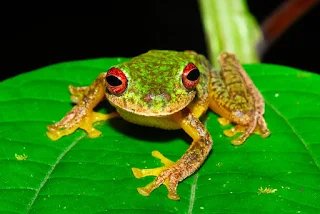Amphibian fungal panzootic causes catastrophic loss of biodiversity
Anthropogenic trade and development have broken down dispersal barriers, facilitating the spread of diseases that threaten Earth’s biodiversity. We present a global, quantitative assessment of the amphibian chytridiomycosis panzootic, one of the most impactful examples of disease spread, and demonstrate its role in the decline of at least 501 amphibian species over the past half-century, including 90 presumed extinctions. The effects of chytridiomycosis have been greatest in large-bodied, range-restricted anurans in wet climates in the Americas and Australia. Declines peaked in the 1980s, and only 12% of declined species show signs of recovery, whereas 39% are experiencing ongoing decline. There is risk of further chytridiomycosis outbreaks in new areas. The chytridiomycosis panzootic represents the greatest recorded loss of biodiversity attributable to a disease.
REFERENCE:
Scheele BC et al. Amphibian fungal panzootic causes catastrophic and ongoing loss of biodiversity. 29 Mar 2019: Vol. 363, Issue 6434, pp. 1459-1463 DOI: 10.1126/science.aav0379
-----------------------------------------------------------
Sigue este Blog en Facebook y Twitter
Ayúdanos a traducir las fichas de seguridad de microorganismos.
www.seguridadbiologica.blogspot.com
-----------------------------------------------------------
REFERENCE:
Scheele BC et al. Amphibian fungal panzootic causes catastrophic and ongoing loss of biodiversity. 29 Mar 2019: Vol. 363, Issue 6434, pp. 1459-1463 DOI: 10.1126/science.aav0379
-----------------------------------------------------------
Sigue este Blog en Facebook y Twitter
Ayúdanos a traducir las fichas de seguridad de microorganismos.
www.seguridadbiologica.blogspot.com
-----------------------------------------------------------




Comentarios